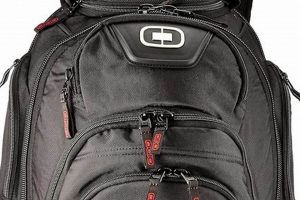Modular Lightweight Load-carrying Equipment (MOLLE) is a system widely employed on backpacks to enhance their carrying capacity and organizational capabilities. It features heavy-duty nylon webbing stitched onto the pack, creating rows of loops. These loops serve as attachment points for compatible pouches, accessories, and gear, significantly expanding the utility of the base backpack. For example, a standard backpack might be customized with water bottle holders, first-aid kits, or tool pouches using this system.
The utilization of this modular system offers numerous advantages, including increased versatility, efficient organization, and customizable load distribution. Historically, this system evolved from military applications where adaptability and the ability to carry mission-specific equipment were paramount. Its robust design and inherent flexibility have since made it popular among outdoor enthusiasts, travelers, and professionals who require a customizable and reliable carrying solution.
The following sections will delve into the specific types of compatible accessories, methods for secure attachment, considerations for optimal weight distribution, and maintenance tips to ensure the longevity and functionality of a pack enhanced with this modular carrying capability.
Tips for Utilizing Modular Backpack Accessories
This section provides practical advice for effectively employing modular accessories on backpacks to maximize their utility and ensure secure and balanced load carriage.
Tip 1: Prioritize Accessory Selection: Before attaching any accessories, carefully assess individual needs and the intended use of the backpack. Avoid overloading with unnecessary pouches or items that contribute excessive weight or bulk.
Tip 2: Ensure Secure Attachment: Properly weave the accessory straps through the webbing on the backpack. A secure attachment prevents shifting during movement and reduces the risk of loss or damage to equipment.
Tip 3: Distribute Weight Evenly: Strive for balanced weight distribution to maintain comfort and stability. Place heavier items closer to the backpack’s frame and centered to avoid strain on the shoulders and back.
Tip 4: Consider Accessory Compatibility: Verify that the chosen accessories are compatible with the backpack’s webbing. Different manufacturers may use slightly varying loop spacing or webbing widths.
Tip 5: Regularly Inspect Attachments: Periodically check the security of all attachments, especially after strenuous activity or prolonged use. Tighten any loose straps or re-weave them as needed.
Tip 6: Organize Accessories Logically: Arrange accessories in a logical and accessible manner, placing frequently used items within easy reach. This streamlines access to essential gear in the field.
Tip 7: Minimize Accessory Profile: Avoid attaching accessories that protrude excessively from the backpack, as this can increase the risk of snagging or hinder movement in confined spaces.
Effective application of these tips enhances the functionality and usability of backpacks with modular attachment systems, promoting efficient and comfortable load carriage.
The following sections will offer a more detailed look into specific types of attachments and their optimal use cases.
1. Compatibility
Compatibility is a foundational element governing the effectiveness of modular attachments for backpacks. Without ensuring compatible dimensions and design, the entire system risks failure, rendering the modular concept ineffective and potentially compromising load security and user safety.
- Webbing Standards
Webbing standards dictate the spacing and width of the horizontal straps on both the backpack and the attachment. Adherence to standardized measurements, primarily those defined within the PALS (Pouch Attachment Ladder System), is critical. Non-compliance results in attachments that are either too loose, making them prone to shifting or detachment, or too tight, precluding proper weaving and secure fastening. For instance, a pouch designed for 1-inch webbing will not securely attach to a pack with wider or narrower webbing.
- Attachment Method
Different attachments employ various methods for securing to the webbing, including straps, clips, and specialized interlocking systems. The chosen method must be physically compatible with the weave pattern of the backpack’s webbing. Certain clips may not function correctly with tightly woven or reinforced webbing, while some strap designs might prove cumbersome or insecure on certain webbing configurations. Consider, for example, that malice clips require a specific webbing thickness to properly function.
- Material Compatibility
Material compatibility is related to wear and tear. Ensure that the attachment’s material, for example nylon, is compatible with the backpack material so it doesn’t weaken or damage the original bag. Combining incompatible materials might lead to accelerated wear and tear.
The facets discussed above underscore the paramount importance of compatibility when selecting and utilizing modular attachments for backpacks. Careful attention to these details safeguards the investment in the system and ensures the reliability and longevity of the load-carrying solution.
2. Weight Distribution
Weight distribution is a critical factor directly impacted by the addition of modular attachments to a backpack. The system, while designed to increase carrying capacity, inherently alters the original weight balance. Incorrect placement of pouches and gear can lead to uneven load bearing, causing discomfort, fatigue, and potentially long-term physical strain. For instance, attaching multiple heavy pouches solely to one side of a backpack throws off the center of gravity, leading to instability and requiring the wearer to expend extra energy to maintain balance. This is not only inefficient but can also increase the risk of falls, particularly on uneven terrain.
Effective weight distribution, when using attachments, involves strategically positioning items based on their weight and frequency of use. Heavier items should be placed closer to the wearer’s center of gravity, ideally high and centered on the back panel, to minimize leverage and strain. Frequently accessed items should be positioned in easily reachable locations, such as side or front pouches, while maintaining balanced weight on both sides. An example of this is placing a water reservoir on one side and a similarly weighted first-aid kit on the opposite side to offset the volume of the water, promoting equilibrium. Furthermore, adjusting the compression straps on the backpack is vital, ensuring that the load is pulled closer to the frame for a more stable carry.
Understanding the impact of modular attachments on weight distribution is paramount for maximizing comfort, minimizing strain, and maintaining stability. By carefully considering the placement and weight of each attachment, users can optimize the carrying capacity of their backpacks without compromising their physical well-being or increasing the risk of injury. Therefore, a deliberate and thoughtful approach to load organization is essential for realizing the full benefits of modular carrying systems. This consideration forms the basis of effective and safe utilization of modular backpack attachments.
3. Attachment Security
Attachment security is a paramount concern when utilizing modular attachments for backpacks. It directly impacts the reliability and effectiveness of the carrying system, influencing the safety of transported gear and the user’s ability to perform intended tasks. Compromised security can lead to loss of essential equipment, posing risks in various environments.
- Webbing Integrity
The webbing on both the backpack and the attachments must maintain structural integrity. Fraying, tearing, or degradation of the webbing compromises the strength of the connection, potentially leading to attachment failure. Regular inspection and prompt repair or replacement of damaged webbing are essential. For example, prolonged exposure to UV radiation can weaken nylon webbing, requiring more frequent evaluation and potential replacement.
- Fastener Reliability
Fasteners, such as straps, buckles, snaps, or hook-and-loop closures, are critical components in maintaining secure attachments. The selected fasteners must be robust enough to withstand the anticipated load and environmental conditions. Regular assessment of fastener functionality and prompt replacement of worn or damaged components is crucial. A broken buckle on a pouch containing essential survival gear can have significant consequences.
- Proper Weaving Technique
The method used to weave the attachment straps through the backpack’s webbing significantly affects the security of the connection. Incorrect weaving techniques can result in loose attachments that are prone to shifting or detachment. Adhering to recommended weaving patterns and ensuring snug and secure connections are essential. A poorly woven attachment may appear secure initially but loosen under stress, potentially dislodging the attached item.
- Environmental Resistance
The attachment system must be resistant to environmental factors such as moisture, temperature fluctuations, and abrasion. Materials and construction methods should be selected to withstand anticipated conditions. Exposure to harsh environments can accelerate wear and tear, reducing attachment security. For example, metallic fasteners may corrode in humid environments, weakening the connection, while abrasive contact with rocks or vegetation can fray webbing over time.
These facets underscore the significance of attachment security in the context of modular attachments for backpacks. By addressing these factors through careful material selection, proper maintenance, and adherence to recommended usage practices, the reliability and effectiveness of the modular carrying system can be maximized, ensuring the safe and secure transport of essential gear.
4. Accessibility
Accessibility, in the context of modular attachments for backpacks, defines the ease and speed with which a user can retrieve specific items or gear. It is a critical aspect of effective load carriage, impacting efficiency and, in certain scenarios, safety. Properly configured modular attachments enhance accessibility by providing readily available storage locations tailored to individual needs.
- Placement Strategy
The location of attached pouches directly impacts accessibility. Frequently used items, such as first-aid kits or communication devices, should be placed in easily reachable positions, typically on the sides or front of the backpack. Less frequently used items can be placed in less accessible locations, such as the rear of the pack. This strategic placement minimizes time spent searching for necessary equipment, particularly in urgent situations. For example, attaching a knife sheath to the shoulder strap ensures immediate access in emergency scenarios.
- Attachment Type
The type of attachment mechanism influences how quickly items can be accessed. Pouches with quick-release buckles or hook-and-loop closures offer faster access compared to those with more elaborate fastening systems. The choice of attachment type should align with the frequency of access and the criticality of the contents. A magazine pouch with a quick-release flap is preferable for rapid access in tactical situations, while a securely buckled pouch might be suitable for less frequently needed items.
- Organization Within Pouches
The internal organization of attached pouches contributes significantly to overall accessibility. Utilizing dividers, elastic loops, or specialized inserts within pouches allows for efficient arrangement and quick identification of specific items. Randomly packed pouches increase search time and hinder access. For instance, a well-organized first-aid kit with labeled compartments for bandages, antiseptic wipes, and pain relievers allows for swift retrieval of necessary supplies.
- One-Handed Operation
Accessibility should ideally extend to one-handed operation, particularly in situations where the user’s other hand is occupied or injured. Attachments and pouches designed for one-handed access enhance usability and safety. For example, a water bottle pouch with an elastic retention cord allows for quick removal and replacement of the bottle with a single hand.
The interconnectedness of placement strategy, attachment type, internal organization, and one-handed operation highlights the multifaceted nature of accessibility in relation to modular attachments for backpacks. By carefully considering these facets, users can optimize their carrying system for efficiency, convenience, and enhanced operational readiness.
5. Durability
Durability is an indispensable attribute of modular attachments for backpacks, directly impacting their lifespan, reliability, and the overall effectiveness of the load-carrying system. The inherent function of these attachments involves bearing weight, enduring environmental stressors, and resisting wear and tear. A lack of durability renders the modular system vulnerable to failure, potentially compromising the safety of carried equipment and hindering operational capabilities. For instance, a poorly constructed pouch designed to hold essential navigation tools may fail under stress, resulting in the loss of those tools and jeopardizing the user’s ability to navigate safely. The connection between durability and functionality, therefore, is both direct and critical.
The causes of compromised durability in modular attachments often stem from material selection, construction techniques, and environmental factors. Inferior materials, such as low-grade nylon or substandard stitching, will exhibit premature wear and tear. Inadequate construction, such as improperly reinforced stress points or flimsy fastening mechanisms, can lead to attachment failure under load. Exposure to harsh environmental conditions, including extreme temperatures, UV radiation, and moisture, accelerates material degradation. Understanding these contributing factors allows for informed selection of durable attachments built to withstand anticipated conditions. A practical application of this understanding involves choosing attachments constructed from high-denier nylon with reinforced stitching and corrosion-resistant hardware for use in harsh outdoor environments.
In summary, durability represents a crucial component of modular attachments for backpacks, directly influencing their reliability and longevity. Challenges arise in balancing durability with weight and cost, requiring careful consideration of material properties and construction methods. Selecting attachments designed to withstand intended use conditions, along with implementing routine maintenance practices, is essential for maximizing the lifespan and performance of the modular load-carrying system. The benefits of a durable and well-maintained system extend to increased user safety, enhanced operational efficiency, and reduced equipment loss.
Frequently Asked Questions
This section addresses common inquiries regarding the implementation and utilization of modular attachments on backpacks, providing clarity on essential aspects of the system.
Question 1: What defines a compatible modular attachment for a backpack?
Compatibility is primarily determined by adherence to established webbing standards, predominantly PALS (Pouch Attachment Ladder System). Dimensions, attachment methods, and material characteristics must align to ensure secure and functional integration.
Question 2: How does the addition of modular attachments affect the weight distribution of a backpack?
The addition of pouches and gear alters the original weight balance. Strategic placement of items based on weight and frequency of use is necessary to maintain comfort and stability. Heavier items should be positioned closer to the wearer’s center of gravity.
Question 3: What constitutes a secure attachment of a modular pouch to a backpack?
Secure attachment involves ensuring the integrity of the webbing, the reliability of fasteners, and the utilization of proper weaving techniques. Fasteners must withstand anticipated loads and environmental conditions, while weaving patterns should prevent shifting or detachment.
Question 4: How can accessibility be maximized when using modular attachments?
Accessibility is enhanced through strategic placement of pouches, selection of appropriate attachment types, organization within pouches, and the facilitation of one-handed operation. Frequently used items should be positioned in easily reachable locations.
Question 5: What factors contribute to the durability of modular attachments?
Durability is influenced by material selection, construction techniques, and resistance to environmental factors. High-quality materials, reinforced construction, and protection against moisture and UV radiation contribute to long-term performance.
Question 6: How often should modular attachments be inspected for wear and tear?
Regular inspection is essential, especially after strenuous activity or prolonged use. Webbing, fasteners, and stitching should be examined for signs of damage or degradation, and prompt repairs should be performed to maintain system integrity.
The understanding and proper application of these principles promotes the effective and safe utilization of modular attachments, enhancing the utility and longevity of backpack systems.
The following section will provide a conclusion.
Conclusion
The preceding analysis underscores the multifaceted nature of molle attachments for backpack systems. The examination of compatibility, weight distribution, attachment security, accessibility, and durability reveals the critical considerations necessary for optimizing the utility and safety of load-bearing equipment. Understanding these elements allows for informed decisions regarding the selection, configuration, and maintenance of such systems.
Continued adherence to best practices in attachment and maintenance remains essential for maximizing the lifespan and functionality of these systems. Furthermore, ongoing innovation in materials and design promises to further enhance the capabilities and reliability of modular load-carrying solutions. Rigorous evaluation and practical application will define the future of this evolving technology.




![Best Storage Backpack [Gear] for Organized Backpackers! Ultimate Backpack Traveler Guide: Tips, Destinations & Budget Hacks Best Storage Backpack [Gear] for Organized Backpackers! | Ultimate Backpack Traveler Guide: Tips, Destinations & Budget Hacks](https://backpack-traveler.com/wp-content/uploads/2025/11/th-758-300x200.jpg)


